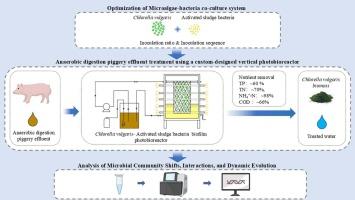The establishment of a microalgae-bacteria co-culture system for real anaerobic digestion piggery effluent treatment
IF 4.5
2区 生物学
Q1 BIOTECHNOLOGY & APPLIED MICROBIOLOGY
Algal Research-Biomass Biofuels and Bioproducts
Pub Date : 2025-09-22
DOI:10.1016/j.algal.2025.104321
引用次数: 0
Abstract
A microalgae-bacteria co-culture system was established by combining in-situ activated sludge bacteria (ASB) with Chlorella vulgaris (C. vulgaris) for the treatment of real anaerobic digestion piggery effluent (ADPE). The results suggest that the optimal strategy for establishing the co-culture system is an initial inoculation with ASB for one day, followed by C. vulgaris, with an inoculation ratio of 1:1. Subsequently, a custom-designed C. vulgaris-ASB biofilm photobioreactor was employed for scale-up testing under semi-continuous operation. This photobioreactor demonstrated competitive performance in treating ADPE, achieving removal efficiencies of approximately 60 %, 70 %, 98 % and 66 % for total phosphorus (TP), total nitrogen (TN), ammonia nitrogen (NH4+-H) and chemical oxygen demand (COD), respectively. Interestingly, a higher renewal rate of ADPE contributed to more efficient COD removal, which is typically considered the most challenging parameter in wastewater treatment. Benefiting from the effective COD reduction, the effluent under 30 % renewal conditions met the discharge standards for pollutants from livestock and poultry breeding (GB18596–2022, China). Microbiome analysis reveals that higher ADPE renewal rates were correlated with increased microbial biodiversity. This study highlights the great potential of the C. vulgaris-ASB consortia system to treat real ADPE while simultaneously facilitating microalgal biomass recovery.

建立微藻-细菌共培养系统,实现猪场污水的厌氧消化处理
将原位活性污泥细菌(ASB)与普通小球藻(C. vulgaris)结合,建立了微藻-细菌共培养体系,用于处理真实厌氧消化猪舍出水(ADPE)。结果表明,建立共培养体系的最佳策略是先接种ASB 1 d,然后接种C. vulgaris,接种比例为1:1。随后,采用定制的C. vulgaris-ASB生物膜光生物反应器在半连续操作下进行放大试验。该光生物反应器在处理ADPE方面表现出良好的性能,对总磷(TP)、总氮(TN)、氨氮(NH4+-H)和化学需氧量(COD)的去除率分别约为60%、70%、98%和66%。有趣的是,更高的ADPE更新率有助于更有效地去除COD,这通常被认为是废水处理中最具挑战性的参数。在30%更新条件下,有效降低COD,出水达到《畜禽养殖污染物排放标准》(GB18596-2022)。微生物组分析显示,较高的ADPE更新率与微生物多样性增加相关。该研究强调了C. vulgaris-ASB联合体系统在处理真实ADPE的同时促进微藻生物量回收的巨大潜力。
本文章由计算机程序翻译,如有差异,请以英文原文为准。
求助全文
约1分钟内获得全文
求助全文
来源期刊

Algal Research-Biomass Biofuels and Bioproducts
BIOTECHNOLOGY & APPLIED MICROBIOLOGY-
CiteScore
9.40
自引率
7.80%
发文量
332
期刊介绍:
Algal Research is an international phycology journal covering all areas of emerging technologies in algae biology, biomass production, cultivation, harvesting, extraction, bioproducts, biorefinery, engineering, and econometrics. Algae is defined to include cyanobacteria, microalgae, and protists and symbionts of interest in biotechnology. The journal publishes original research and reviews for the following scope: algal biology, including but not exclusive to: phylogeny, biodiversity, molecular traits, metabolic regulation, and genetic engineering, algal cultivation, e.g. phototrophic systems, heterotrophic systems, and mixotrophic systems, algal harvesting and extraction systems, biotechnology to convert algal biomass and components into biofuels and bioproducts, e.g., nutraceuticals, pharmaceuticals, animal feed, plastics, etc. algal products and their economic assessment
 求助内容:
求助内容: 应助结果提醒方式:
应助结果提醒方式:


